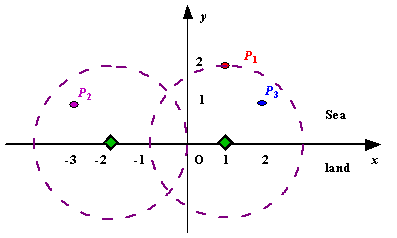poj1328 Radar Installation
| Time Limit: 1000MS | Memory Limit: 10000K | |
| Total Submissions: 101197 | Accepted: 22509 |
Description
Assume the coasting is an infinite straight line. Land is in one side of coasting, sea in the other. Each small island is a point locating in the sea side. And any radar installation, locating on the coasting, can only cover d distance, so an island in the sea can be covered by a radius installation, if the distance between them is at most d.
We use Cartesian coordinate system, defining the coasting is the x-axis. The sea side is above x-axis, and the land side below. Given the position of each island in the sea, and given the distance of the coverage of the radar installation, your task is to write a program to find the minimal number of radar installations to cover all the islands. Note that the position of an island is represented by its x-y coordinates.

Figure A Sample Input of Radar Installations
We use Cartesian coordinate system, defining the coasting is the x-axis. The sea side is above x-axis, and the land side below. Given the position of each island in the sea, and given the distance of the coverage of the radar installation, your task is to write a program to find the minimal number of radar installations to cover all the islands. Note that the position of an island is represented by its x-y coordinates.

Figure A Sample Input of Radar Installations
Input
The input consists of several test cases. The first line of each case contains two integers n (1<=n<=1000) and d, where n is the number of islands in the sea and d is the distance of coverage of the radar installation. This is followed by n lines each containing two integers representing the coordinate of the position of each island. Then a blank line follows to separate the cases.
The input is terminated by a line containing pair of zeros
The input is terminated by a line containing pair of zeros
Output
For each test case output one line consisting of the test case number followed by the minimal number of radar installations needed. "-1" installation means no solution for that case.
Sample Input
3 2 1 2 -3 1 2 1
1 2 0 2 0 0
Sample Output
Case 1: 2 Case 2: 1
每个岛看作一个点,情况1.如果雷达的扫描范围d小于到岛的距离的话,自然是无解了。情况2.但如果,雷达的扫描范围d大于到岛的距离的话,就要分一个雷达可以扫描几个岛了。以此为切入点。
想放最少的雷达,那么岛的范围有重合的话,在最后一个重合的始端放一个雷达就可以。
范围有无重合,就看前一个岛和后一个岛在x轴的结束点和开始点的位置关系。
#include <iostream>
#include <algorithm>
#include <cmath>
using namespace std;
struct point //按岛在x轴上的范围的左开始点从左到右 大小排序
{
int x,y;
double e,s;
bool operator < (const point a) const{
return e<a.e;
}
}p[1010];
int main()
{
int n;
double d;
int kase=0; //case
while (cin>>n>>d&&(n||d))
{
bool flag=false; //为后面1 2情况准备
for (int i=0;i<n;i++)
{
cin>>p[i].x >>p[i].y;
if (fabs(p[i].y)>d)
{
flag=true; //情况1
}
else //情况2 可以扫描到的话,x轴上开始结束点 勾股定理求得
{
p[i].s=p[i].x*1.0 - sqrt(d*d-p[i].y*p[i].y);
p[i].e=p[i].x*1.0 + sqrt(d*d-p[i].y*p[i].y);
}
}
cout<<"Case "<<++kase<<": ";
if (flag) //情况1无解输出-1
{
cout<<-1<<endl;
}
else
{
int rad=1; //只要符合情况2,开始就有雷达
sort(p,p+n);
double temp=p[0].e; //令temp等于第一个岛在x轴的开始点,与后面的岛的结束点比较
for (int i=1;i<n;i++)
{
if (p[i].s>temp) //如果后一个岛的开始大于前一个岛的结束,,即范围不重合的话,放雷达
{
rad++;
temp=p[i].e;
}
}
cout<<rad<<endl;
}
}
}